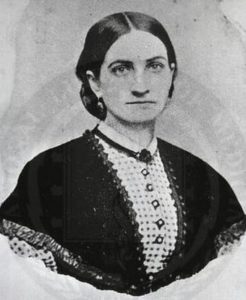
Kate Cumming: Confederate Nurse and Author
The month of March is Women’s History Month, a time in which we commemorate and encourage the study, observance and celebration of the vital role of women in American history. Here at the Tunnel, we will be posting several blogs about women’s roles during the Civil War, including two specific women who will be featured in new exhibits at the Heritage Center.
The first woman is Kate Cumming, a Confederate Civil War nurse. Born in Scotland circa 1830, Kate Cumming moved to Mobile, Alabama with her family when she was young.[1] When the Civil War began in 1861, Cumming joined the home front relief effort, gathering supplies for hospitals. After hearing a speech advocating for more wartime nurses in April 1862, Kate volunteered her services for the Confederate army, even though she had no medical training. She left Mobile and spent several months in Corinth, MS. There she cared for the confederate soldiers who were wounded during the Battle of Shiloh.
Even with all the difficulties, Kate served through June and then traveled to serve in Chattanooga. Her duties were many and included delivering food and medicine, managing laundresses, writing letters, keeping clothing and bedding fresh, and even cooking.[2] In September of 1862, new laws officially allowed employed women to be recognized by the Confederate medical department. Cumming received the rank of matron, or hospital supervisor. After Chattanooga fell to the Union forces in 1863, she moved to Georgia and served in field hospitals. This was necessary to the destruction left by William T. Sherman during his Atlanta Campaign. She was stationed in many cities including Dalton, Ringgold, Rome, and Tunnel Hill.
After the end of the Civil War in 1865, matrons and nurses were among the first southerners to publish their observations of the war. Cumming returned home to Mobile and published her diary in 1866 as A Journal of Hospital Life in the Confederate Army of Tennessee from the Battle of Shiloh to the End of the War: With Sketches of Life and Character, and Brief Notices of Current Events During That Period. It was not initially received well by readers, perhaps because it was too close to the events or because of the influx of similar Confederate books. Later, in 1895, she republished the journal under the title, Gleanings from Southland. This shortened, edited version experienced more success.
Kate never married and moved to Birmingham, Alabama in 1874. There she worked as a teacher and an active member of the United Daughters of the Confederacy until she died in 1909. Kate’s journal is invaluable as it is the most complete and realistic records of Confederate hospitals and the services of matrons.
Kate Cumming is on display in the Clisby Austin House. We have a short excerpt from her diary and she is shown in a field hospital setting. Come and take a tour and see the new display. We would love to share more about Kate and others directly involved with the Civil War in our area.
[1] http://www.encyclopediaofalabama.org/article/h-1101
[2] https://library.uab.edu/locations/reynolds/collections/civil-war/medical-figures/kate-cumming




